Eric Connelly
The Box-Cox Transform
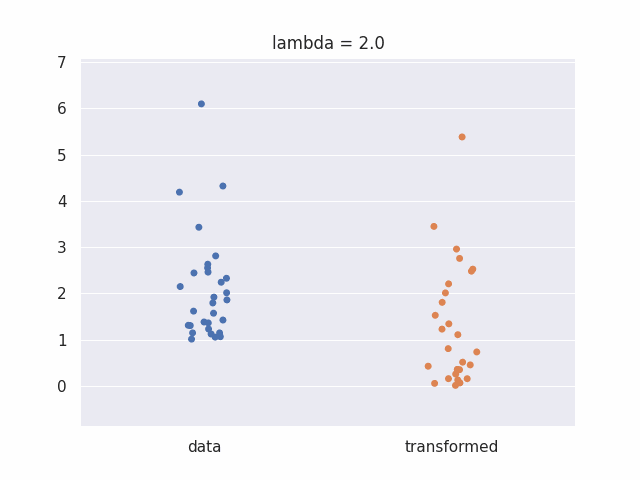
For this post we will be showing how the box-cox transform acts on skewed data.
The idea is that given data with some sort of skew, we can use a box-cox transform to make it more normally distributed.
From Wikipedia, we have the box cox transform:
\[y_i^{(\lambda)} = \begin{cases} \dfrac{y_i^\lambda - 1}{\lambda} & \text{if } \lambda \neq 0, \\ \ln y_i & \text{if } \lambda = 0, \end{cases}\]https://en.wikipedia.org/wiki/Power_transform#Box%E2%80%93Cox_transformation
,
where lambda is a parameter that we can vary until our transformed data is approximately normally distributed.
import numpy as np
import matplotlib.pyplot as plt
import seaborn as sns
import matplotlib.animation as animation
sns.set_theme()
First we generate some skewed data from an F distribution. Fisrt we plot a kde plot of the data, and then a strip plot.
def skewed_kde():
m=30
a = 1+np.random.f(2,10, m)
sns.kdeplot(a)
sns.rugplot(a)
# plt.savefig('skewed_kde_data.png',bbox_inches='tight')
plt.show()
np.random.seed(0)
skewed_kde()
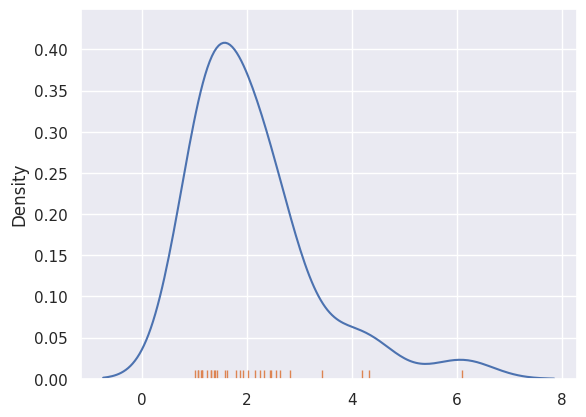
def skewed_strip():
m=30
a = 1+np.random.f(2,10, m)
sns.catplot(a)
# plt.savefig('skewed_strip_data.png',bbox_inches='tight')
plt.show()
np.random.seed(0)
skewed_strip()
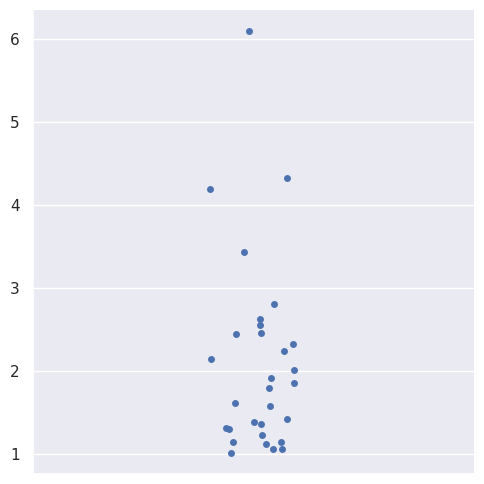
Box-Cox Transform
Below is the transform we will be applying.
From Wikipedia, we have the box cox transform:
\[y_i^{(\lambda)} = \begin{cases} \dfrac{y_i^\lambda - 1}{\lambda} & \text{if } \lambda \neq 0, \\ \ln y_i & \text{if } \lambda = 0, \end{cases}\]https://en.wikipedia.org/wiki/Power_transform#Box%E2%80%93Cox_transformation
,
where lambda is a parameter that we can vary until our transformed data is approximately normally distributed.
The Transform
The function below transforms data based on the parameter lambda.
def my_box_cox(y , lambda_):
if lambda_ == 0:
y_new = np.log(y)
else:
y_new = (y**lambda_ - 1) / lambda_
return y_new
Transforming Skewed Data
Using our box cox transform function, we can transform skewed data.
Before applying our transform, we will try transforming our data using a logarithm.
np.random.seed(0)
m=30
a = 1+np.random.f(2,10, m)
b = np.log(a)
sns.catplot([a ,b], orient='v')
plt.xticks([0,1] , ['data' , 'transformed'])
plt.show()
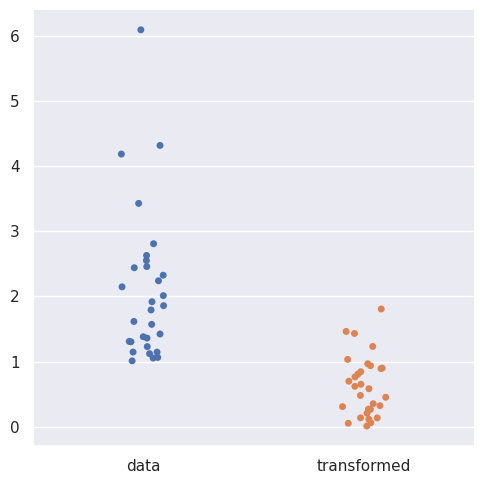
sns.violinplot([a ,b], orient='v')
plt.xticks([0,1] , ['data' , 'transformed'])
plt.show()
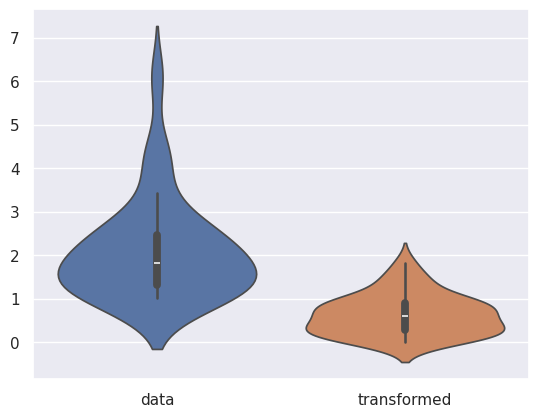
The above violin plot shows that by applying a logarithm, our data becomes more symmetric.
Now we will apply our box cox transofrm with different values of lambda.
def show_boxcox_transform_catplot(m,lambda_):
a = 1+np.random.f(2,10, m)
b = my_box_cox(a,lambda_)
sns.stripplot([a ,b], orient='v').set_title(f'lambda = {lambda_}')
g = plt.xticks([0,1] , ['data' , 'transformed'])
plt.show()
return g
We can look at an animated plot to see what the box cox transform does to our data at different values of lambda:

With lambda set to zero, our transformation is the same as applying a logarithm:
np.random.seed(0)
show_boxcox_transform_catplot(m =30,lambda_ = 0);
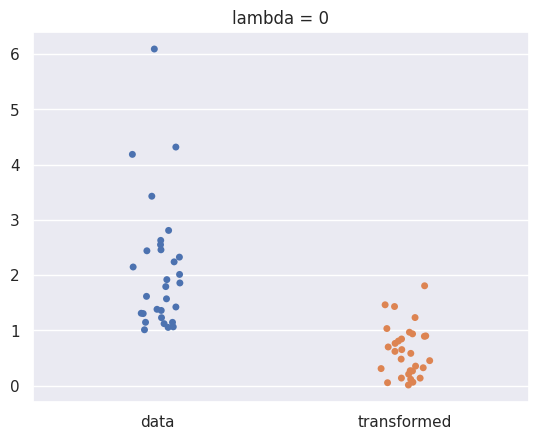
Other values of lambda:
np.random.seed(0)
show_boxcox_transform_catplot(m =30,lambda_ = 1);
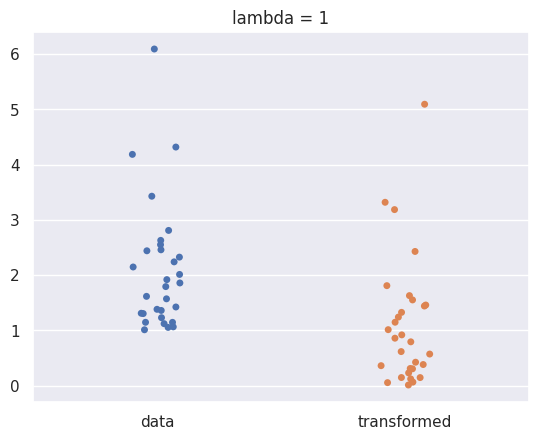
np.random.seed(0)
show_boxcox_transform_catplot(m =30,lambda_ = 0.5);
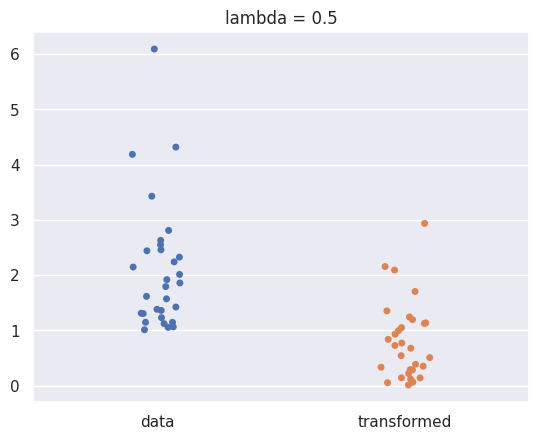
np.random.seed(0)
show_boxcox_transform_catplot(m =30,lambda_ = -1);
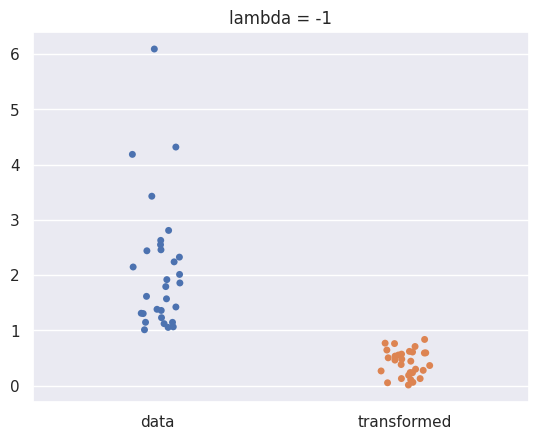
np.random.seed(0)
show_boxcox_transform_catplot(m =30,lambda_ = -2);
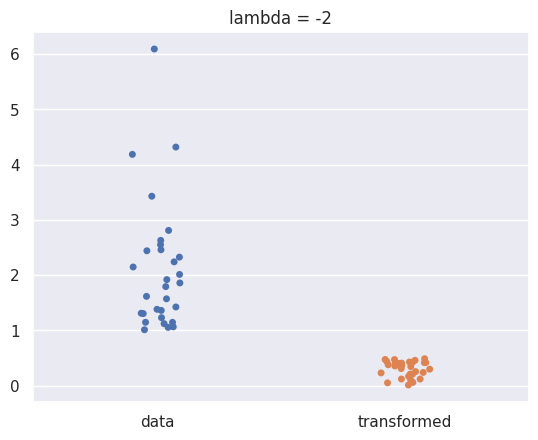
Code to make the Animation
graphing and what not
import numpy as np
import matplotlib.pyplot as plt
import seaborn as sns
import matplotlib.animation as animation
m = 30
lambda_ = 2
fig , ax = plt.subplots()
np.random.seed(0)
a = 1+np.random.f(2,10, m)
b = my_box_cox(a,lambda_)
sns.stripplot([a ,b], orient='v' , ax = ax)
ax.set_xticks([0,1] , ['data' , 'transformed'])
ax.set_title(f'lambda = {lambda_}')
ax.set_ylim(top=a.max()+1)
def update(frame):
# for each frame, update the data stored on each artist.
b = my_box_cox(a , lambda_ - frame*0.1)
# print(ax.collections[1].get_offsets().data.shape)
data = ax.collections[1].get_offsets().data
if type(data) == 'numpy.ndarray':
data[:,1] = b
ax.collections[1].set_offsets(data)
else:
data2 = np.array(data)
data2[:,1] = b
ax.collections[1].set_offsets(data2)
# print(xs.shape)
# data = np.stack([xs,b]).T
ax.set_title(f'lambda = {np.round(lambda_ - frame*0.1, 2)}')
return ax
ani = animation.FuncAnimation(fig=fig, func=update, frames=40, interval=100)
#Uncomment to save animation:
# ani.save(filename="moving_strip_post.gif", writer="pillow")